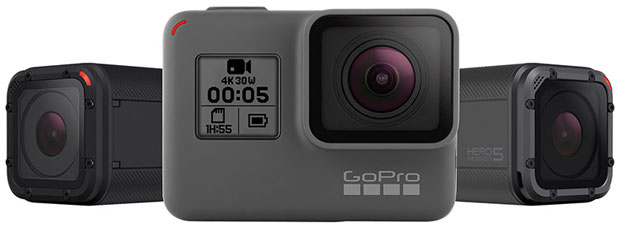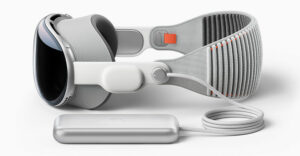GoPro earlier this week refreshed its product line, announcing two new action cameras, a cloud service and a drone.
Its new Hero5 Black camera (US$399.99) can capture 4K video at 30 frames a second and still photos at 12 megapixels, with RAW and WDR support.
It has a 2-inch touch display, and stereo sound recording with advanced wind noise reduction. It can be voice-controlled in seven languages. The shooter will be available Oct. 2.
Unlike prior models, the Hero5 Black is waterproof to 33 feet without the need for a separate housing.
Other features include automatic uploading of a camera’s contents to GoPro’s new cloud subscription service, compatibility with existing GoPro mounts, professional-grade electronic video stabilization, and GPS support.
Flying Karma
GoPro also announced the Hero5 Session camera ($299), a smaller model with many of the same features as the Black — 4K video, 10MP photos, auto loading to the cloud, voice control, waterproofing, mount compatibility, video stabilization, and a linear-view setting for removing distortion in wide-angle videos and stills.
GoPro’s drone, Karma, is small enough to fit in backpack — and to prove it, a backback is included with the Unmanned Aerial Device.
The flyer has a game-style controller with a touch display, so you don’t need a phone or tablet to see what the drone sees.
In addition, the unit’s three-axis camera stabilizer can be removed and attached to a grip included with the package for handheld recording or for recording from other GoPro mounts.
Karma will be available in early 2017 for $799.99. Karma plus a Hero5 Black will cost $1,099.99, and Karma bundled with a Hero5 Session will go for $999.99.
“With these new products, we’re delivering on our promise to make it easy to capture and share engaging stories,” said GoPro CEO Nicholas Woodman.
Missing Features
Introduction of a drone is a natural extension of GoPro’s core wearable camera business, and bundling its new cameras with Karma is likely to benefit sales of both devices, noted Barbara Kraus, director of research at Parks Associates.
“However, the Karma does not have obstacle detection, which is likely to be considered a detriment,” she told TechNewsWorld. “Major drone maker DJI’s Phantom 4 does have obstacle detection, which is an important safety feature because drones can be dangerous.”
Karma’s battery life of 20 minutes is on the short side, observed Ken Hyers, director for wireless device strategies at Strategy Analytics.
“That means that after you’ve recharged the batteries five or six times, your flight time is going to be averaging 15 minutes a flight or 5 or 6 minutes less than a competitor’s drone,” he told TechNewsWorld.
Further, the unit lacks a true “follow me” mode, and can’t be programmed to follow a point-to-point course, Hyers pointed out.
“It looks like a very good first generation device,” he said. “They’re going to learn a lot from it, but it’s certainly not this year’s model in this market.”
Late to the Party
GoPro has taken a big step forward in delivering more performance and convenience to its customers, maintained Andreas Scherer, a managing partner at Salto Partners and a GoPro user.
“All in all, the product lineup makes sense,” he told TechNewsWorld. “The package has the potential to simplify many steps in generating high-quality videos.”
However, there are many alternatives to GoPro, and some of them already are entrenched in their markets, he added. “If anything, GoPro is late to the party in cloud services for photo enthusiasts and drones.”
Adrenaline Junkies Wanted
With the introduction of Karma, GoPro hopes to move up the value chain and capture Hero users who are also drone users, noted Philip Solis, a research director at ABI Research.
However, even if it accomplishes that, the stakes will be small, he maintained.
The drone market is worth about $1 billion, Solis estimated. Half of that is the prosumer market that Karma targets. About 60 percent of that market is owned by DJI. That leaves about $200 million for the rest of the players — and GoPro is just one of many.
“Even if GoPro gets a decent market share, they’re not going to ship a lot of things — so if it’s supposed to be a driver to help them sell more cameras, it’s not going to be all that great,” Solis told TechNewsWorld.
Whether GoPro stands to realize big bucks in drones may be beside the point, though, because drone makers have begun to undermine GoPro’s position in the action-cam market by selling drones equipped with their own cameras.
“GoPro started to see an erosion of its market, because these drone manufacturers were targeting outdoor enthusiasts who wanted to take action shots of their mountain biking or snowboarding,” Dronelife Editor-in-Chief Frank Schroth told TechNewsWorld.
It’s possible that GoPro is going into drones because it has tapped out its core market, suggested Strategy Analytics’ Hyer. “GoPro has reached everybody who’s an adrenaline junkie. They had very rapid growth, and now they’re looking for new directions.”























































Another good product from GoPro. I like how its video resolution is clear and high quality. ANd of course, what could be better than a waterproof camera like Hero5. I need to try it out to see how it works.